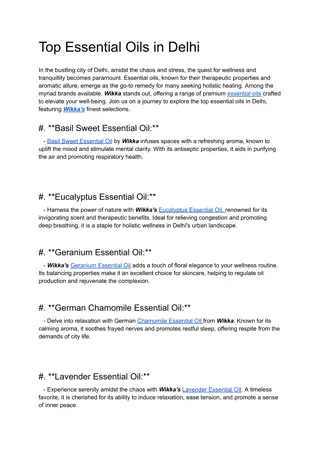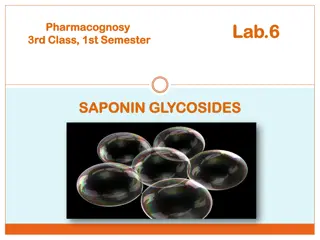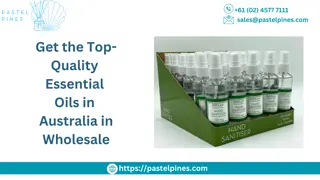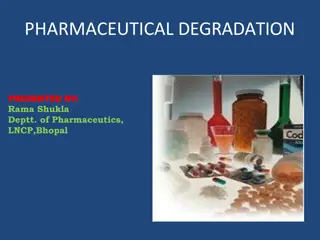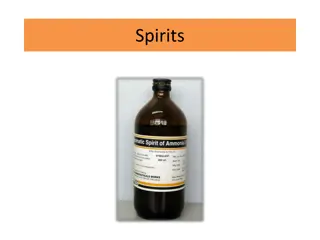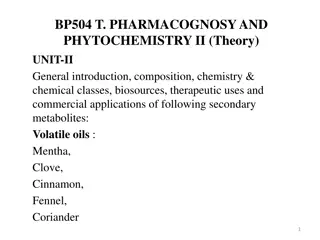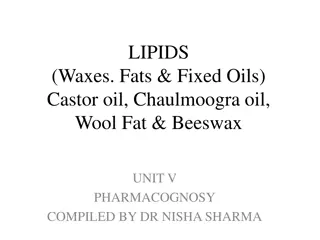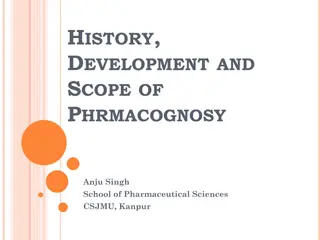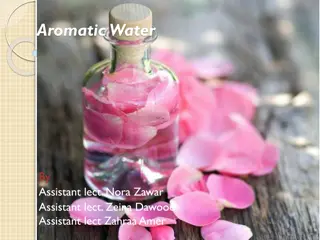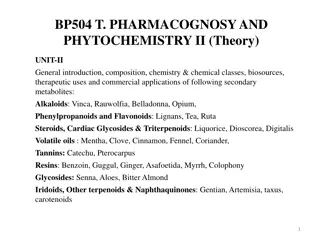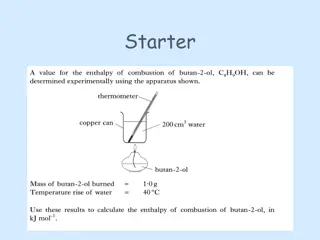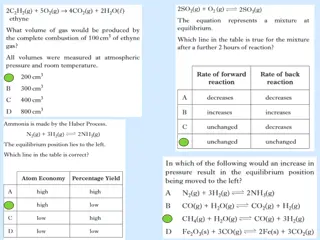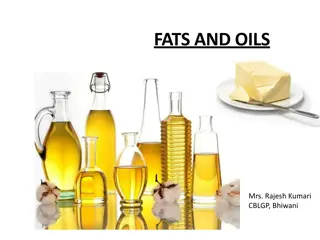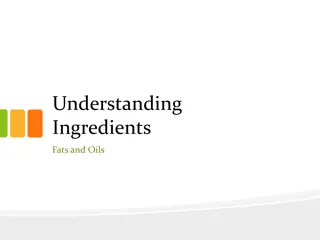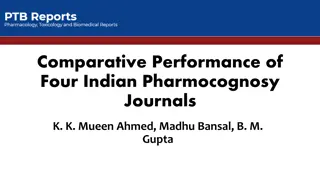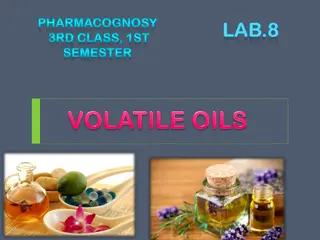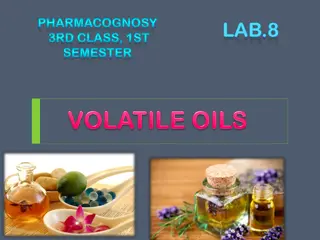Essential Insights on Volatile Oils and Their Properties in Pharmacognosy
Explore the fascinating world of volatile oils in pharmacognosy with Dr. Nisha Sharma, an Associate Professor at C.S.J.M. University. Learn about the physical and chemical properties of volatile oils, their classification based on functional groups, and examples of different types of volatile oils used in medicinal applications. Gain a deeper understanding of these odorous and volatile plant-derived compounds essential in the field of pharmacy.
Download Presentation

Please find below an Image/Link to download the presentation.
The content on the website is provided AS IS for your information and personal use only. It may not be sold, licensed, or shared on other websites without obtaining consent from the author.If you encounter any issues during the download, it is possible that the publisher has removed the file from their server.
You are allowed to download the files provided on this website for personal or commercial use, subject to the condition that they are used lawfully. All files are the property of their respective owners.
The content on the website is provided AS IS for your information and personal use only. It may not be sold, licensed, or shared on other websites without obtaining consent from the author.
E N D
Presentation Transcript
Name of the Content Creator: Dr. Nisha Sharma Designation: Associate Professor Email: nishasharma@csjmu.ac.in Email of Registrar: registrarcsjmuknp@gmail.com Institute Name: University Institute of Pharmacy University Name: C.S.J.M. University Campus, Kanpur 1
B.PHARM. 4th SEMESTER BP405 T. PHARMACOGNOSY AND PHYTOCHEMISTRY II (Theory) UNIT-IV INTRODUCTION TO SECONDARY METABOLITES VOLATILE OILS Dr. Nisha Sharma Associate Professor (Former Head) University Institute of Pharmacy C.S.J.M. University, Kanpur nishasharma@csjmu.ac.in 2
Volatile Oils These are Odorous volatile principles of plant & animal source, they evaporate if exposed to air at ordinary temperature, hence known as volatile or etheral oils. Essence of active constituents of the plant - known as essential oils.
PROPERTIES OF VOLATILE OILS Physical Properties Volatile in nature Have characteristic odor & flavor Solubility: Immiscible in water, fairly sol. in alcohol, freely sol. in ether, CHCl3 Lighter than water, exception: clove oil is heavier Most of them are colorless liq. Have Refractive index ex. Cinnamon oil: 1.562-1.582 Most of them are optically active Cumin oil: +4 to +8 Chemical Properties 1. 2. 3. 1.They are derived from terpene Mostly mono & sesquiterpenes & their oxygenated derivatives i.e. terpenoids 2. Terpenes are built of Isoprene unit (C5H8) 4. 3. They are open chain or cyclic unsaturated compound, have 1 or more double bonds 4. Thermal decomposition: Isoprene as one of the product 5. 6. 7. 5. Have olefinic bond, easily oxidised by all oxidising agents 6. Terpenoids undergo addition reaction with H2 & halogen acids.
Classification Volatile oils are classified on the basis of functional groups present Groups Drugs Hydrocarbons Turpentine oil Alcohols Peppermint, sandalwood oil Aldehydes Lemongrass, cinnamon, cassia, saffron Ketones Camphor, caraway, dill, jatamansi, fennel Phenols Clove, ajowan, tulsi Phenolic ethers Nutmeg Oxides Eucalyptus, cardamom, chenopodium oil Esters Valerian, rosemary, garlic, gaultheria oil
CLASSIFICATION OF VOLATILE OIL SN CLASS STRUCTURE CONSTITUEN TS NAME OF DRUG 1 A B Hydrocarbon volatile oil Monocyclic Bicyclic Limonene -Pinene Cardamon Coriander oil OH 2 Esters of Volatile oil Methyl Salicylate Winter green oil COOCH3 3 Ether Volatile oil Anethole Fennel Anise OCH3 CH CH CH3
CLASSIFICATION OF VOLATILE OIL SN CLASS STRUCTURE CONSTITUENTS NAME OF DRUG 4 Alcohol Volatile oil CH3 Citronellol Lemon Grass a. Acyclic CH2OH b. Monocyclic Menthol Peppermint OH 5 Aldehyde volatile oil Citral Lemon CHO
CLASSIFICATION OF VOLATILE OIL SN CLASS STRUCTURE CONSTITUENTS NAME OF DRUG 6 Ketone Volatile Oil Camphor Camphor O O Carvone Caraway 7 Oxides Volatile oils Cineole Eucalyptus Oil O 8 Phenol Volatile oil Eugenol Clove OH OCH3 Thymol Mint CH2 CH2 CH OH
TERPENOIDS Group of naturally occurring compounds Terpenes or Terpenoids are volatile substances which give plants and flowers their fragrance. Term terpene was given to the compounds isolated from terpentine, a volatile liquid isolated from pine trees. Terpenoids are the hydrocarbons of plant origin of the general formula (C5H8)n as well as their oxygenated, hydrogenated, and dehydrogenated derivatives. The simpler mono and sesquiterpenes is the chief constituent of the essential oils obtained from sap and tissues of certain plant and trees. The di- and triterpenoids are not steam volatile. They are obtained from plant and tree gums and resins. Tertraterpenoids form a separate group of compounds called Carotenoids . The term terpene was originally used to describe a mixture of isomeric hydrocarbons with molecular formula C10H16 occurring in the essential oils. But more general term is terpenoids , which includes hydrocarbons and their oxygenated derivatives.
Classification Terpenoids classified on the basis of number of carbon atoms present in the structure. Number of carbon atoms Value of n Class Formula 10 2 Monoterpenoids C10H16 15 3 Sesquiterpenoids C15H24 20 4 Diterpenoids C20H32 25 5 Sesterpenoids C25H40 30 6 Triterpenoids C30H48 40 8 Tetraterpenoids C40H64 40 8 Polyterpenoids (C5H8)n
Identification Tests Natural drugs containing volatile oils can be tested by following chemical tests: 1. Thin section of drug + alcoholic solution of Sudan III red color confirm volatile oils. 2. Thin section of drug + tincture of alkana red colour presence of volatile oils 3. Volatile oil smeared on thin paper Temporary stain disappears on exposure 4. Specific test for camphor: natural camphor +vanillin + H2SO4(1:100) Yellow changes to red, violet and finally blue (series of color changes)
REFERENCES Pharmacognosy, C.K. Kokate, A.P. Purohit, S.B. Gokhale, 54th Ed. 2017, Nirali Publication, New Delhi Trease and Evans Pharmacognosy, W.C. Evans, 15th Ed. Elsevier, 2002.


